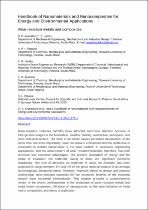JavaScript is disabled for your browser. Some features of this site may not work without it.
- ResearchSpace
- →
- Research Publications/Outputs
- →
- Book Chapters
- →
- View Item
| dc.contributor.author |
Aramide, BP

|
|
| dc.contributor.author |
Popoola, API

|
|
| dc.contributor.author |
Sadiku, ER

|
|
| dc.contributor.author |
Aramide, FO

|
|
| dc.contributor.author |
Pityana, Sisa L

|
|
| dc.date.accessioned | 2020-10-27T12:27:23Z | |
| dc.date.available | 2020-10-27T12:27:23Z | |
| dc.date.issued | 2020-07 | |
| dc.identifier.citation | Aramide, B.P., Popoola, A.P.I., Sadiku, E.R., et al. 2020. Wear-resistant metals and composites. In: Kharissova, O.V., Torres-Martinez, L.M., Kharisov, B.I. (eds) Handbook of Nanomaterials and Nanocomposites for Energy and Environmental Applications, pp. 1-25 | en_US |
| dc.identifier.isbn | 978-3-030-36269-0 | |
| dc.identifier.isbn | 978-3-030-36268-3 | |
| dc.identifier.isbn | 978-3-030-36267-6 | |
| dc.identifier.uri | https://www.springer.com/gp/book/9783030362676 | |
| dc.identifier.uri | http://hdl.handle.net/10204/11638 | |
| dc.description | Copyright: 2020, Switzerland: Springer. Due to copyright restrictions, the attached PDF file contains the abstract of the full-text item. For access to the full-text item, please consult the publisher's website. | en_US |
| dc.description.abstract | Wear-resistant materials (WRMs) have attracted enormous attention because of their general usages in the biomedical, medical, military, automotive, aerospace, and other industrial sectors. The wear of an article causes persistent devaluation, at the same time, but more importantly, wear can make a component become ineffective or vulnerable to sudden failure.Wear is the main problem in numerous engineering applications, and the advancement of wear-resistant materials, therefore, has both technical and economic advantages. The present dissipation of energy and the waste of treasured raw materials, owing to wear, are significant economic drawbacks. The cost of abrasion, on materials of value, for example, has been projected to range between 1% and 4% of the gross national product of an average technologically advanced nation. Recently, research efforts to design and produce cutting-edge wear-resistant materials for the economic benefits of the industrial sectors have increased tremendously. This chapter presents a comprehensive review of the recent developments in the production of wear-resistant metals and metal matrix composites, influence of nanoparticles on the wear behavior of metal matrix composites, and areas of application. | en_US |
| dc.language.iso | en | en_US |
| dc.publisher | Switzerland: Springer | en_US |
| dc.relation.ispartofseries | Workflow;23795 | |
| dc.subject | Biomedicine | en_US |
| dc.subject | Industries | en_US |
| dc.subject | Military | en_US |
| dc.subject | Metal matrix composites | en_US |
| dc.subject | Nanoparticles | en_US |
| dc.subject | Wear-resistant materials | en_US |
| dc.title | Wear-resistant metals and composites | en_US |
| dc.type | Book Chapter | en_US |
| dc.identifier.apacitation | Aramide, B., Popoola, A., Sadiku, E., Aramide, F., & Pityana, S. L. (2020). Wear-Resistant metals and composites., <i>Workflow;23795</i> Switzerland: Springer. http://hdl.handle.net/10204/11638 | en_ZA |
| dc.identifier.chicagocitation | Aramide, BP, API Popoola, ER Sadiku, FO Aramide, and Sisa L Pityana. "Wear-resistant metals and composites" In <i>WORKFLOW;23795</i>, n.p.: Switzerland: Springer. 2020. http://hdl.handle.net/10204/11638. | en_ZA |
| dc.identifier.vancouvercitation | Aramide B, Popoola A, Sadiku E, Aramide F, Pityana SL. Wear-resistant metals and composites.. Workflow;23795. [place unknown]: Switzerland: Springer; 2020. [cited yyyy month dd]. http://hdl.handle.net/10204/11638. | en_ZA |
| dc.identifier.ris | TY - Book Chapter AU - Aramide, BP AU - Popoola, API AU - Sadiku, ER AU - Aramide, FO AU - Pityana, Sisa L AB - Wear-resistant materials (WRMs) have attracted enormous attention because of their general usages in the biomedical, medical, military, automotive, aerospace, and other industrial sectors. The wear of an article causes persistent devaluation, at the same time, but more importantly, wear can make a component become ineffective or vulnerable to sudden failure.Wear is the main problem in numerous engineering applications, and the advancement of wear-resistant materials, therefore, has both technical and economic advantages. The present dissipation of energy and the waste of treasured raw materials, owing to wear, are significant economic drawbacks. The cost of abrasion, on materials of value, for example, has been projected to range between 1% and 4% of the gross national product of an average technologically advanced nation. Recently, research efforts to design and produce cutting-edge wear-resistant materials for the economic benefits of the industrial sectors have increased tremendously. This chapter presents a comprehensive review of the recent developments in the production of wear-resistant metals and metal matrix composites, influence of nanoparticles on the wear behavior of metal matrix composites, and areas of application. DA - 2020-07 DB - ResearchSpace DP - CSIR KW - Biomedicine KW - Industries KW - Military KW - Metal matrix composites KW - Nanoparticles KW - Wear-resistant materials LK - https://researchspace.csir.co.za PY - 2020 SM - 978-3-030-36269-0 SM - 978-3-030-36268-3 SM - 978-3-030-36267-6 T1 - Wear-resistant metals and composites TI - Wear-resistant metals and composites UR - http://hdl.handle.net/10204/11638 ER - | en_ZA |






